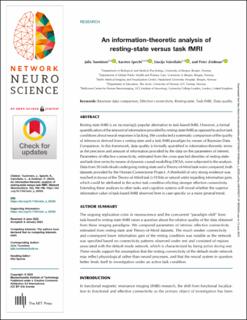| dc.contributor.author | Tuominen, Julia Axiina | |
| dc.contributor.author | Specht, Karsten | |
| dc.contributor.author | Vaisvilaite, Liucija | |
| dc.contributor.author | Zeidman, Peter | |
| dc.date.accessioned | 2023-06-13T11:30:52Z | |
| dc.date.available | 2023-06-13T11:30:52Z | |
| dc.date.created | 2023-01-16T14:57:54Z | |
| dc.date.issued | 2023 | |
| dc.identifier.issn | 2472-1751 | |
| dc.identifier.uri | https://hdl.handle.net/11250/3071118 | |
| dc.description.abstract | Resting-state fMRI is an increasingly popular alternative to task-based fMRI. However, a formal quantification of the amount of information provided by resting-state fMRI as opposed to active task conditions about neural responses is lacking. We conducted a systematic comparison of the quality of inferences derived from a resting-state and a task fMRI paradigm by means of Bayesian Data Comparison. In this framework, data quality is formally quantified in information-theoretic terms as the precision and amount of information provided by the data on the parameters of interest. Parameters of effective connectivity, estimated from the cross-spectral densities of resting-state- and task time series by means of dynamic causal modelling (DCM), were subjected to the analysis. Data from 50 individuals undergoing resting-state and a Theory-of-Mind task were compared, both datasets provided by the Human Connectome Project. A threshold of very strong evidence was reached in favour of the Theory-of-Mind task (>10 bits or natural units) regarding information gain, which could be attributed to the active task condition eliciting stronger effective connectivity. Extending these analyses to other tasks and cognitive systems will reveal whether the superior informative value of task-based fMRI observed here is case specific or a more general trend. | en_US |
| dc.language.iso | eng | en_US |
| dc.publisher | MIT Press | en_US |
| dc.rights | Navngivelse 4.0 Internasjonal | * |
| dc.rights.uri | http://creativecommons.org/licenses/by/4.0/deed.no | * |
| dc.title | An Information-Theoretic Analysis of Resting-State versus Task fMRI | en_US |
| dc.type | Journal article | en_US |
| dc.type | Peer reviewed | en_US |
| dc.description.version | publishedVersion | en_US |
| dc.rights.holder | Copyright 2023 Massachusetts Institute of Technology | en_US |
| cristin.ispublished | true | |
| cristin.fulltext | postprint | |
| cristin.qualitycode | 1 | |
| dc.identifier.doi | 10.1162/netn_a_00302 | |
| dc.identifier.cristin | 2107831 | |
| dc.source.journal | Network Neuroscience | en_US |
| dc.source.pagenumber | 769-786 | en_US |
| dc.relation.project | Norges forskningsråd: 276044 | en_US |
| dc.identifier.citation | Network Neuroscience. 2023, 7 (2), 769-786. | en_US |
| dc.source.volume | 7 | en_US |
| dc.source.issue | 2 | en_US |

